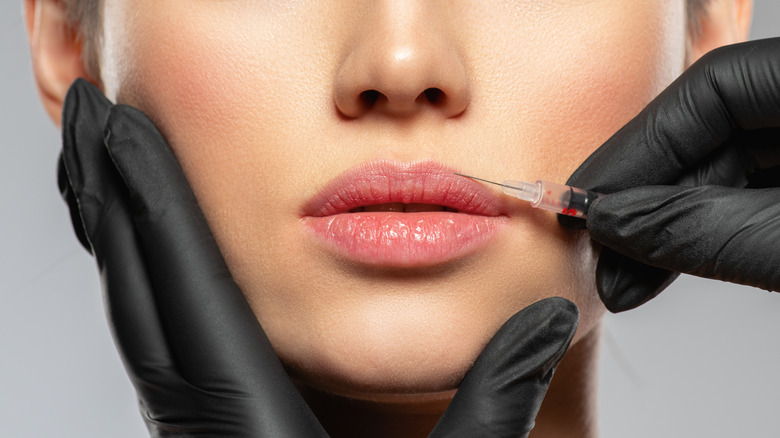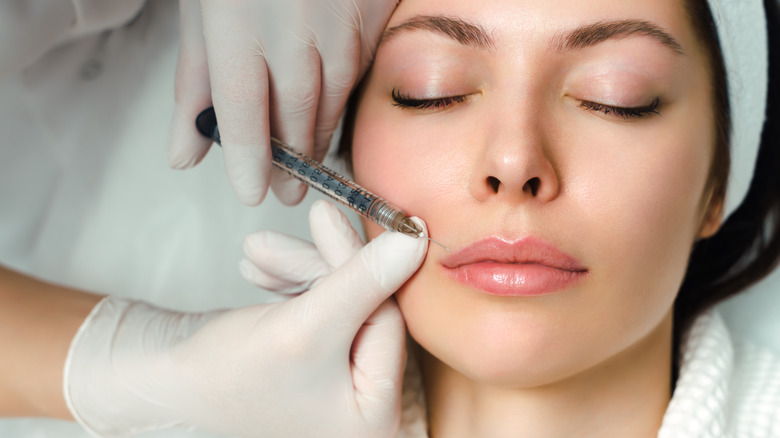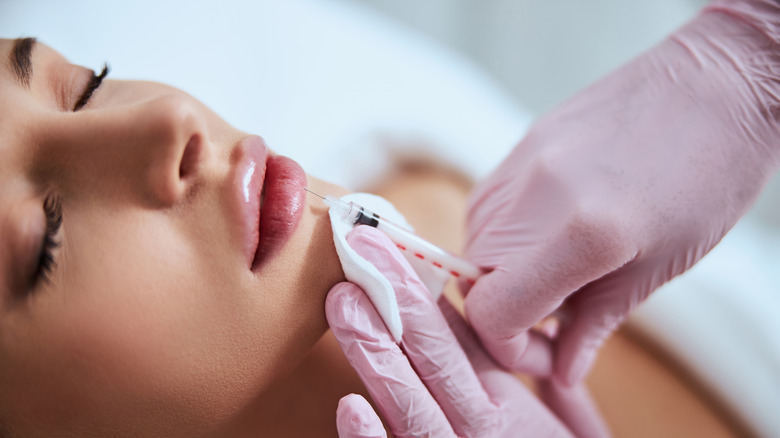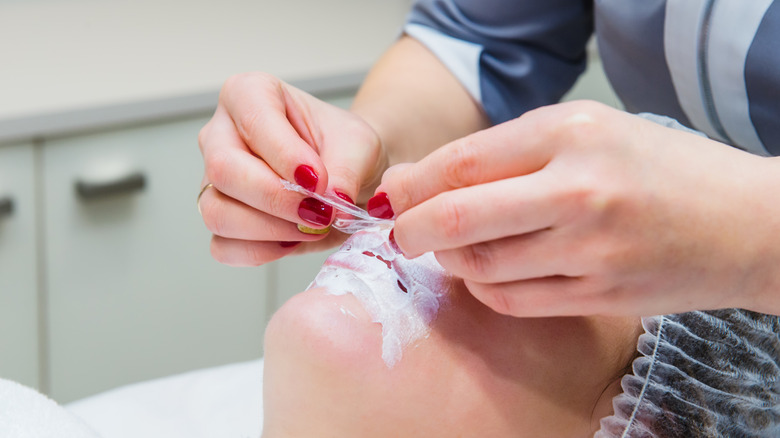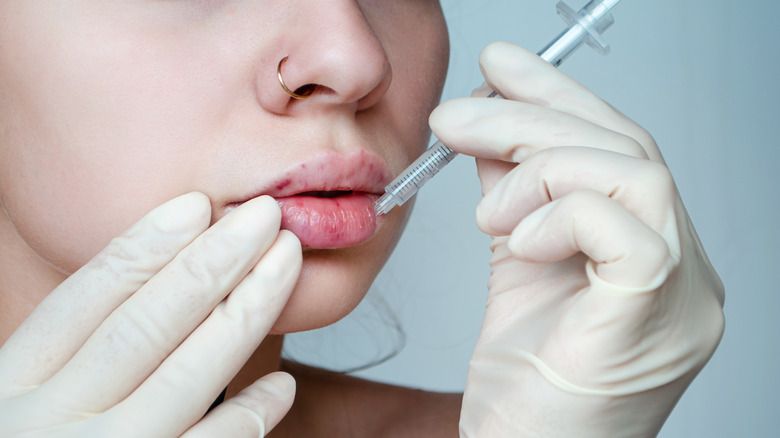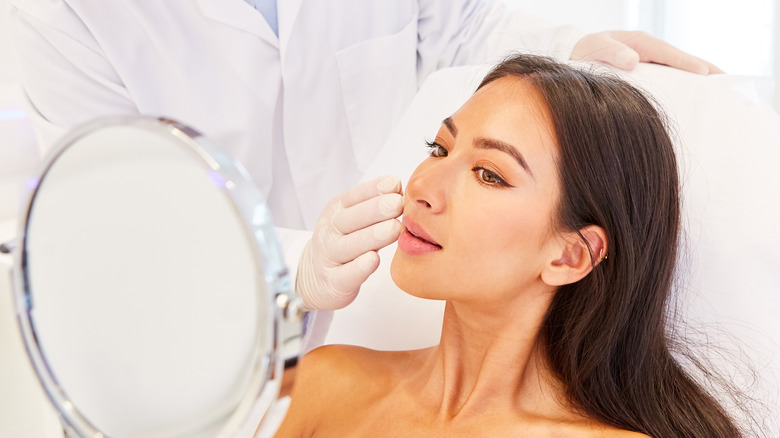What To Expect When Getting Lip Filler Injections
The art of lip filler injections has come a long way. From the 1800s to the 1980s, providers injected early filler patients with everything from paraffin to silicone, according to research published in the medical journal Facial Plastic Surgery. The use of primitive injectables frequently led to unsightly complications, such as lip filler migration. Today's lip filler agents are typically made using hyaluronic acid, a naturally occurring substance in the body that's considered far safer than previous injectables. Thanks to the increased popularity of lip fillers over time, providers have also developed advanced injection techniques to achieve optimal results.
Still, if you've been thinking of getting lip fillers, there are many variables to consider. Critics of lip fillers are quick to point out the risks associated with the procedure, and such warnings can be scary for first-timers or those on the fence. However, research published in the Journal of Cosmetic Dermatology examined over 20 lip filler-related studies and concluded that the procedures are generally safe. In order to minimize the risk of complications or unsatisfactory results, it's essential to do your homework on lip fillers, starting with choosing the right provider. So, how can you find the best lip filler doctor, and what are some things you should know before getting lip injections?
Researching the right lip filler provider for your needs
Let's get one thing straight: not everyone who performs lip injections is a doctor. Until recently, providers in the United Kingdom could inject dermal fillers, including lip fillers, without any type of license or medical training, per the BBC. In the United States, however, anyone who injects fillers must be a licensed medical professional, though specific requirements can vary by state (via the U.S. Food & Drug Administration). "Getting injectables is not equivalent to a hair or makeup appointment. [They] are a cosmetic medical procedure with real risks that should be done in a medical environment," Dr. Heidi Waldorf tells Women's Health. Don't be shy about asking questions, either. You want to ensure that your provider is educated and experienced in administering lip fillers.
Furthermore, you'll want to consider your aesthetic goals when it comes to getting lip fillers. Providers use conservative amounts of lip filler to smooth the appearance of ridges or smokers' lines and larger doses for enhanced fullness and volume. First-time lip filler patients are often advised to start slow with small quantities of product. "Ten years ago, lip fillers were about subtlety. Then the pendulum swung all the way to the overdone 'Instagram' lips. Now, I feel like we've settled into a happy medium, where there's more interest in shape, border definition, [and] soft hydration," Dr. Sarmela Sunder tells RealSelf. Whether you're looking for a barely-there boost or a visibly pronounced pout, look at the potential provider's body of work and read up on patient reviews.
Things to know prior to your lip filler appointment
Your provider might ask about your preferred lip filler product prior to your appointment. Two of the most commonly used hyaluronic acid injectables for lips are Restylane Kysse and Juvéderm Ultra. Kysse is a newer product that's purported to look and feel softer than Juvéderm, but its natural appearance might not be enough for those looking for amped-up volume. "Kysse doesn't do as well combined with other fillers in the lips. So, it's best for 'virgin' lips or for lips that have only been injected with Kysse previously," dermatologist Matthew B. Doppelt tells RealSelf. If you've never had lip injections before and are testing the waters, Kysse is your best bet. But for those who want maximum plumpness and long-lasting effects, Juvéderm is considered the go-to choice.
You should take note of a few things as you prepare for your lip filler appointment. It may sound strange, but you'll want to steer clear of the dentist's chair for at least two weeks before the procedure. According to research published in the Journal of Maxillofacial and Oral Surgery, dental work scheduled too closely to filler appointments can lead to complications such as infection. "We advise [lip filler] patients to stop any supplements that may increase the risk of bruising, such as fish oil, and other medications, such as NSAIDs or Aspirin," Dr. Rhonda Klein tells Allure. Additionally, cigarette or e-cigarette users should try to quit smoking prior to their procedure date, as nicotine can delay the healing process.
What happens when you arrive for your procedure
It doesn't matter if you're a seasoned lip injection patient or a total newbie; it's normal to feel butterflies on the day of your filler appointment. Once you arrive at the clinic, it can help to listen to some calming music or text friends for support as you wait for the provider. The risk of serious complications associated with lip filler is low, but it's important to address any of your concerns with your provider if you're still feeling a bit nervous. "[Ask] whether there is an aftercare plan in place, and what they would do if things go wrong," Dr. Tijion Esho tells Harper's Bazaar. Many providers will offer safety information prior to the date of the appointment, but it doesn't hurt to speak with them directly before the procedure.
Your injectionist will likely ask a few questions regarding your desired aesthetic outcome, and they may look for areas of asymmetry in your lips that they can correct using filler. If there are certain qualities you don't like about your lips, like a pronounced cupid's bow, make sure to communicate these concerns before the procedure begins. Filler can't change the shape of your lips entirely, but it can be used to downplay and emphasize different attributes. The provider will give you the option of using numbing cream on your lips a few minutes before the injections take place, and some clinics may even offer you a stress ball to squeeze during the treatment.
How to help your lip filler injections heal faster
After they've finished placing the lip filler injections, your provider will give you an ice pack to soothe your skin and minimize the chance of bruising. However, you'll likely experience some degree of swelling over the next few days. "You may notice that on social media, post-lip injection photos are often taken right after the procedure — needle marks are usually even still visible! This bears little or no resemblance to what your lips will look like two weeks after injections," plastic surgeon Dara Liotta tells Vogue. While some may be delighted by the initial bee-stung look, others may find it off-putting. Many plastic surgeons suggest using a topical arnica cream made for the lips or an arnica supplement, like Boiron's Arnica Montana Pellets, to expedite the healing process and reduce bruising.
Moderate swelling from lip filler is common, usually peaking about a week after injections, but more serious complications could arise in rare cases. "Potential dangers [associated with filler] include infection, deformity, blindness, and even death. It's important to select a properly qualified injector who has extensive knowledge of anatomy and how to treat complications if they occur," Dr. Matthew Schulman tells CNN. Contact your provider's office or its direct line if you notice unusual side effects, like discoloration, pain, or excessive swelling. If you're unable to reach them, don't hesitate to call your primary care doctor or the nearest emergency department. Many conditions associated with lip filler are benign, but it's crucial to assess their severity in the first days or weeks following treatment.
The final results of fully healed lip filler
About two to three weeks after your lip filler appointment, most of the swelling from the procedure should subside. Some filler providers recommend massaging the lips around the two-week mark to soothe any residual swelling or lumps, but it's important to be gentle. "Moderate to severe pressure and manipulation in the area not only can move the filler but also may exacerbate any existing swelling," Dr. Melanie Palm tells Insider. Displaced filler, also known as filler migration, can cause a loss of lip volume as the filler settles in areas around the mouth. After getting lip injections, it's best to avoid the use of mechanical lip-plumping devices, as these tools can cause the existing filler to break down more rapidly.
Fully healed lips should appear even and free of irregularities, like bumps or redness. If you aren't satisfied with the outcome of your lip filler injections, reach out to your provider for a follow-up consultation. In some cases, lip filler may need to be dissolved or redistributed to correct any signs of asymmetry. For the fullest-looking lips, be sure to drink plenty of water, as the hyaluronic acid in filler responds to your body's hydration levels. You can expect the effects of lip filler to last between 12 and 18 months depending on the product used and your rate of metabolism.
